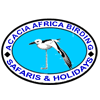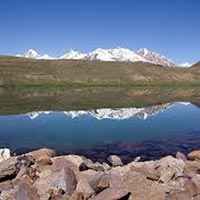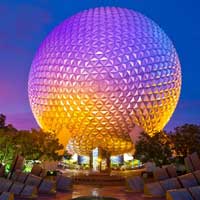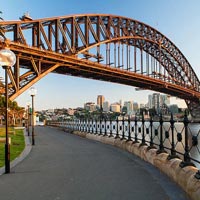+91-8929175340
+91-8929175340
Day 1 : Nairobi
Arrive at Nairobi. Reception at the Jomo Kenyatta airport by Acacia Africa Birding Safari representative and transfer to the Holiday Inn or equivalent hotel.
Day 2 : Nairobi National Park
A day to relax and wear off jet lag but not without an introduction to Kenyan birds. A walk in the vast garden of our hotel (66 acres) will give our first count of African birds: Northern Pied Babbler, Holub's Golden Weaver, Speckled Mousebird, Dusky Turtle Dove and numerous sunbirds. After breakfast we cross over (by bus) to the Nairobi National Park , which despite being only a few kilometers from the city is a home to big game. In its open grasslands scattered with acacia trees we will see the first game like gazelles, zebras, giraffes and maybe some of the cats. If the season is right, the wildebeest that migrates from Tanzania through Masai Mara will also be there. This afternoon we will see Ostrich, Secretary Bird, Crowned Crane, vultures, Cattle and Great Egrets, Tawny Eagle, and a herd of Buffaloes should provide Red-billed Oxpeckers perched on their backs. Black Kite, Marabou Stork, Pied Crow and African Palm Swift are also seen in the park. A walk around the hippo pools should give us our first sighting of the Nile Crocodile and Helmeted Guineafowl. In the Yellow-backed Acacia, look out for Grey Crowned Crane, Red-throated Tit and Chestnut-banded Plover. At the picnic site baboons will quickly assemble on our arrival and just as quick they will easily walk away with a lunch box. The Agama Rock Lizard is common here. Overnight Holiday Inn or equivalent hotel.
Day 3 : Amboseli - Ol Tukai Lodge
After breakfast we head south-east of Nairobi towards Amboseli National Park . On the road we have the chance to see Kori Bustard, Hoopoe, Pale Chanting Goshawk and the very common Augur Buzzard that feels comfortable perched on telephone posts along the road. Amboseli is at the foot of Mount Kilimanjaro and has the advantage of having many swamps that are fed by underground rivers coming from the mountain. This attracts a large population of water birds like African Jacana, Red-knobbed Coot, Egyptian Goose and a wide range of herons and egrets. With 425 species of birds, our two days here should be able to give us a chance to see vultures, eagles, bustards, sandgrouse, Ground Hornbills, Rosy-breasted Longclaw, Sooty Chat, falcons, Barn Owl, Spotted Redshank, Temminck's Stint, Saddle-billed Stork and the hyperactive Black Crake.
In the plains and the scrublands we should be on the look out for Go-away-birds, and a variety of Larks: Red-capped, Rufous-naped and Short-toed that are common in Amboseli. The magic of Amboseli is seeing the big game including the elephant, lion, leopard, cheetah, impala, Grants Gazelle and Eland with the backdrop of the snow capped Kilimanjaro. This is a place for great photos justifying our trip as a photography safari. Overnights at the Ol Tukai Lodge.
Day 4 : Amboseli - Ol Tukai Lodge
After breakfast we head south-east of Nairobi towards Amboseli National Park . On the road we have the chance to see Kori Bustard, Hoopoe, Pale Chanting Goshawk and the very common Augur Buzzard that feels comfortable perched on telephone posts along the road. Amboseli is at the foot of Mount Kilimanjaro and has the advantage of having many swamps that are fed by underground rivers coming from the mountain. This attracts a large population of water birds like African Jacana, Red-knobbed Coot, Egyptian Goose and a wide range of herons and egrets. With 425 species of birds, our two days here should be able to give us a chance to see vultures, eagles, bustards, sandgrouse, Ground Hornbills, Rosy-breasted Longclaw, Sooty Chat, falcons, Barn Owl, Spotted Redshank, Temminck's Stint, Saddle-billed Stork and the hyperactive Black Crake.
In the plains and the scrublands we should be on the look out for Go-away-birds, and a variety of Larks: Red-capped, Rufous-naped and Short-toed that are common in Amboseli. The magic of Amboseli is seeing the big game including the elephant, lion, leopard, cheetah, impala, Grants Gazelle and Eland with the backdrop of the snow capped Kilimanjaro. This is a place for great photos justifying our trip as a photography safari. Overnights at the Ol Tukai Lodge.
Day 5 : Amboseli Towards Lake Elementaita
After breakfast we start our day's journey in the direction of Lake Elementaita . We make a brief stop over at the Limuru swamp for a check on the water birds and at the Kinangop plateau in search of the rare Sharpe's Longclaw. Our destination now is Lake Elementaita Lodge on the shores of Lake Elementaita , an alkaline lake in theRift Valley. We will arrive there in the early afternoon. The huge acacia trees we see during our transfer are favorites with Blue-eared Glossy Starling and Ruppell's Long-tailed Starling. We will stay in a small luxury hotel in unspoiled nature, in comfortable en suite accommodation. Lake Elementaita Lodge
Day 6 : Lake Elementaita
At the hot springs , which feed the lake, ruff, Garganey Teal, Red-billed Duck, Common Sandpiper and Egyptian Goose are residents. On the open grasslands there are the resident Sacred Ibis, Helmeted Guineafowl, Common Rock Thrush and Hildebrandt's Francolin. The setup of the hotel rooms is in a mature garden with different trees and flowers. This means there is no official starting time for our bird-watching activity. Resting on the verandah of your room, it will be possible to see the early risers leave their nests. Check for Purple Grenadier, Mourning Dove, Red-cheeked Cordon-bleu, Klaas's Cuckoo, Black-headed Weaver, Tropical Boubou and Black-headed Bush Shrike. Overnight - Lake Elementaita Lodge
Day 7 : Lake Elementaita - Lake Baringo
After breakfast we head further north to Lake Baringo. This is a fresh water lake with a slight degree of alkalinity. The climate is dry and the cliffs around house a variety of bird life. Over 400 species of birds have been recorded. The woodlands by the lake are alive with White-browed Sparrow-Weavers, Jackson 's and Red-billed Hornbills, Bristle-crowned Starlings, and the rare Northern Masked Weavers, there are several Hamerkops along the lakeshore and with luck we should be able to see their nest, which a pair of Grey Kestrels has adopted as a home. There will be time to relax, enjoy the pool, and bird the grounds of the lodge for the resident Spotted Eagle Owls, and Sunbirds such as the Beautiful, Hunter's and the Violet-backed. Nightjars are common on the lakeshores at night and the hippos graze freely on the lodge's lawn. Overnight is at Lake Baringo Country Club.
Day 8 : Lake Bogoria - Lake Bogoria
After the boat ride we transfer to Lake Bogoria where we will stay in the Lake Bogoria Hotel for two nights. Lake Bogoria , a Ramsar Site, is dominated by the countless hot springs , which pour boiling water into the sterile lake - sterile, except for the massive flocks of Lesser Flamingos that flood into Bogoria each year. Millions of them have been recorded at peak times of the year and hundreds of thousands is common. Greater Flamingos are also present, sometimes in thousands and Black-necked Grebe is usually there. Although no other birds could possibly stand the conditions that the flamingos find rather pleasant (standing up to your knees in boiling, highly caustic soda, is guaranteed to strip the skin of most animals) there is, nevertheless, an abundance of raptors preying on the ready source of meat. Steppe, Fish and Tawny Eagles are present in amazing numbers. In fact, at times, the eagles are so numerous you can see eight or more in a single tree. Baringo is also one of the places in Kenya offering a reasonable chance of seeing Greater Kudu. North of the lake, outside the park, is the Kesubo Swamp . Only recently has the potential of this place been realized and developed as a tourist area. More than 200 species of birds are resident and the swamp holds the Kenyan record for the largest number of bird species seen in one hour - 96! A visit to this swamp can of course not be left out. Overnight at the Lake Bogoria Hotel.
Day 9 : Lake Bogoria - Lake Bogoria
After the boat ride we transfer to Lake Bogoria where we will stay in the Lake Bogoria Hotel for two nights. Lake Bogoria , a Ramsar Site, is dominated by the countless hot springs , which pour boiling water into the sterile lake - sterile, except for the massive flocks of Lesser Flamingos that flood into Bogoria each year. Millions of them have been recorded at peak times of the year and hundreds of thousands is common. Greater Flamingos are also present, sometimes in thousands and Black-necked Grebe is usually there. Although no other birds could possibly stand the conditions that the flamingos find rather pleasant (standing up to your knees in boiling, highly caustic soda, is guaranteed to strip the skin of most animals) there is, nevertheless, an abundance of raptors preying on the ready source of meat. Steppe, Fish and Tawny Eagles are present in amazing numbers. In fact, at times, the eagles are so numerous you can see eight or more in a single tree. Baringo is also one of the places in Kenya offering a reasonable chance of seeing Greater Kudu. North of the lake, outside the park, is the Kesubo Swamp . Only recently has the potential of this place been realized and developed as a tourist area. More than 200 species of birds are resident and the swamp holds the Kenyan record for the largest number of bird species seen in one hour - 96! A visit to this swamp can of course not be left out. Overnight at the Lake Bogoria Hotel.
Day 10 : Kakamega Forest - Rondo Retreat
We aim to reach Kakamega Forest by lunchtime. This forest, in the heart of an intensively cultivated agricultural area, is a superb remainder of virgin tropical rainforest and is of course home to a wide range of specialty birds, many of which are not found anywhere else in Kenya . The forest is not only home to the rare De Brazza's monkey (only found in Kakamega Forest), but also to the Hammer-headed Fruit Bat, Flying Squirrel, 400 species of butterflies and no less than 330 species of birds.
Yes, birding in a forest has its fair share of difficulties but this is easily forgotten when our count increases with hopeful sightings of the impressive Black-and-white-casqued Hornbill, Ross' Turaco and Great Blue Turaco. Other notables are the Grey-headed Negro-Finch, Red-headed Bluebill, Chestnut Wattle-eye, Mackinnon's Shrike and many more. Overnight in the Rondo Retreat in the forest.
Day 11 : Kakamega Forest - Rondo Retreat
We aim to reach Kakamega Forest by lunchtime. This forest, in the heart of an intensively cultivated agricultural area, is a superb remainder of virgin tropical rainforest and is of course home to a wide range of specialty birds, many of which are not found anywhere else in Kenya . The forest is not only home to the rare De Brazza's monkey (only found in Kakamega Forest), but also to the Hammer-headed Fruit Bat, Flying Squirrel, 400 species of butterflies and no less than 330 species of birds.
Yes, birding in a forest has its fair share of difficulties but this is easily forgotten when our count increases with hopeful sightings of the impressive Black-and-white-casqued Hornbill, Ross' Turaco and Great Blue Turaco. Other notables are the Grey-headed Negro-Finch, Red-headed Bluebill, Chestnut Wattle-eye, Mackinnon's Shrike and many more. Overnight in the Rondo Retreat in the forest.
Day 12 : Lake Nakuru - Sarova Lion Hill Lodge
We head south-east to Lake Nakuru which is famous for its thousands of Lesser Flamingos, the Greater Flamingoes will be easily distinguishable by their height. White Pelicans, Dark Egret, and Black-winged Stilt are also there. The lake has a low concentration of salt, so it supports fish that of course attract other water birds.
It is a good place to look for avocets, storks, ibises, ducks, cormorants, herons, and terns. In the wooded acacias there is a chance to see African Firefinch, Arrow-marked Babbler and Narina Trogon. Overnight in the Sarova Lion Hill Lodge in the park.
Day 13 : To Lake Naivasha
We start our day with a game drive through Nakuru National Park, always on the look out for birds and the big game that is here in plenty: vast herds of buffaloes, tens of rhinos, and cats like leopard and lion. Of the big five only the elephant is missing. After the game drive we transfer to Lake Naivasha , this is a fresh water lake without a known outlet. The lake has dense vegetation, which in turn supports a variety of birds. The area has a bird count of 350 species. We reach Lake Naivasha Lodge in time for lunch where we'll stay for the next three nights. In the afternoon we do a bird walk in the garden of the hotel, which borders the lake. A late afternoon boat ride gives us not only the chance to see numerous hippos, but also a wide variety of fresh water birds. A nocturnal visitor in this lodge is the hippo, whose deep munching we will easily identify from the comfort of our rooms.Overnight - Lake Naivasha Lodge
Day 14 : Crescent Island
To have the best sightings of the bird life in Lake Naivasha , Crescent Island is the place of choice. It is a lagoon from where we should be able to see Grey-capped Warbler, Spectacled Weaver, Brimstone Canary and Red-billed Firefinch. There are also a lot of fish-eaters. Both the Long-tailed and Great Cormorant together with the Fish Eagle and the Pied Kingfisher are common here. Overnight - Lake Naivasha Lodge
Day 15 : Masai Mara - Fig Tree Tented Camp
We head to the famous Masai Mara National Reserve, which borders the Serengeti in Tanzania . Mara is the gem of game viewing and bird-watching in Kenya with 450 species recorded. We will drive through Masai land, home to one of the most fascinating cultures in Africa . In the vast grasslands we expect to see elephants, the large cats - lion, leopard, and cheetah, the herd animals - zebra, wildebeest, Thompson's and Grant's Gazelle, and specialties like hartebeest and Topi. Expected bird species are the highly conspicuous Common Ostrich, the small but still conspicuous Cardinal Quelea, Sooty Chat, Ground Hornbill, Open-billed Stork, Temminck's Courser, Yellow-throated Sandgrouse and Denham's Bustard. Lilac-breasted Rollers are common. If we find a kill, we may see six species of vulture all dining together: Egyptian, Hooded, Griffon, Nubian, White-backed and White-headed. It will be a double reward should a hyena or a jackal join in the scramble for the kill. In addition we will encounter numerous raptors such as Bateleur, Martial and Tawny Eagles, as well as Pale Chanting Goshawk, Augur Buzzard and Black- chested Harrier Eagle. Along the Mara River we'll watch for African Finfoot, Schalow's and Ross' Turaco, Crested Guineafowl, Woodland Kingfisher, Yellow-billed Barbet, Black-billed Weaver, Violet-backed Starling, and perhaps with luck, Pel's Fishing Owl. Any tapping noise on the trees may be indicative of the relatively uncommon Woodpeckers (Golden-tailed, Little Spotted and Fine-banded). Hopefully we will be lucky enough to see some of the more difficult to see mammals such as Bat-eared Fox, Hunting Dog, Serval and the delightful Banded Mongoose. Overnight all three days is at the Fig Tree Tented Camp or similar, which is built with a great natural set up, so we will be able to bird-watch easily from the tents.
Day 16 : Masai Mara - Fig Tree Tented Camp
We head to the famous Masai Mara National Reserve, which borders the Serengeti in Tanzania . Mara is the gem of game viewing and bird-watching in Kenya with 450 species recorded. We will drive through Masai land, home to one of the most fascinating cultures in Africa . In the vast grasslands we expect to see elephants, the large cats - lion, leopard, and cheetah, the herd animals - zebra, wildebeest, Thompson's and Grant's Gazelle, and specialties like hartebeest and Topi. Expected bird species are the highly conspicuous Common Ostrich, the small but still conspicuous Cardinal Quelea, Sooty Chat, Ground Hornbill, Open-billed Stork, Temminck's Courser, Yellow-throated Sandgrouse and Denham's Bustard. Lilac-breasted Rollers are common. If we find a kill, we may see six species of vulture all dining together: Egyptian, Hooded, Griffon, Nubian, White-backed and White-headed. It will be a double reward should a hyena or a jackal join in the scramble for the kill. In addition we will encounter numerous raptors such as Bateleur, Martial and Tawny Eagles, as well as Pale Chanting Goshawk, Augur Buzzard and Black- chested Harrier Eagle. Along the Mara River we'll watch for African Finfoot, Schalow's and Ross' Turaco, Crested Guineafowl, Woodland Kingfisher, Yellow-billed Barbet, Black-billed Weaver, Violet-backed Starling, and perhaps with luck, Pel's Fishing Owl. Any tapping noise on the trees may be indicative of the relatively uncommon Woodpeckers (Golden-tailed, Little Spotted and Fine-banded). Hopefully we will be lucky enough to see some of the more difficult to see mammals such as Bat-eared Fox, Hunting Dog, Serval and the delightful Banded Mongoose. Overnight all three days is at the Fig Tree Tented Camp or similar, which is built with a great natural set up, so we will be able to bird-watch easily from the tents.
Day 17 : Masai Mara - Fig Tree Tented Camp
We head to the famous Masai Mara National Reserve, which borders the Serengeti in Tanzania . Mara is the gem of game viewing and bird-watching in Kenya with 450 species recorded. We will drive through Masai land, home to one of the most fascinating cultures in Africa . In the vast grasslands we expect to see elephants, the large cats - lion, leopard, and cheetah, the herd animals - zebra, wildebeest, Thompson's and Grant's Gazelle, and specialties like hartebeest and Topi. Expected bird species are the highly conspicuous Common Ostrich, the small but still conspicuous Cardinal Quelea, Sooty Chat, Ground Hornbill, Open-billed Stork, Temminck's Courser, Yellow-throated Sandgrouse and Denham's Bustard. Lilac-breasted Rollers are common. If we find a kill, we may see six species of vulture all dining together: Egyptian, Hooded, Griffon, Nubian, White-backed and White-headed. It will be a double reward should a hyena or a jackal join in the scramble for the kill. In addition we will encounter numerous raptors such as Bateleur, Martial and Tawny Eagles, as well as Pale Chanting Goshawk, Augur Buzzard and Black- chested Harrier Eagle. Along the Mara River we'll watch for African Finfoot, Schalow's and Ross' Turaco, Crested Guineafowl, Woodland Kingfisher, Yellow-billed Barbet, Black-billed Weaver, Violet-backed Starling, and perhaps with luck, Pel's Fishing Owl. Any tapping noise on the trees may be indicative of the relatively uncommon Woodpeckers (Golden-tailed, Little Spotted and Fine-banded). Hopefully we will be lucky enough to see some of the more difficult to see mammals such as Bat-eared Fox, Hunting Dog, Serval and the delightful Banded Mongoose. Overnight all three days is at the Fig Tree Tented Camp or similar, which is built with a great natural set up, so we will be able to bird-watch easily from the tents.
Day 18 : Back to Nairobi
We leave Masai Mara after breakfast and drive east to Nairobi. We arrive in time for lunch at the best Italiana restaurant in Kenya - Town Restaurant. Transfer at night to the airport where we say goodbye.
Payment Terms & Methods :
* Some Advance Percentage of total booking amount * Airfare/Transport fare to be paid full at one time in advance.
Cancellation & Refund Policy :
* Upon cancellation, refund will be made after deducting the Retention Amount. * Retention Amount varies as per the number of days left before your package start date.
Acacia Africa Birding Safaris View Profile
0 / 5
About Acacia Africa Birding Safaris

Acacia Africa Birding Safaris
0 /5 18D/17N
18D/17N
Mumbai - Kathmandu - New Delhi - Jaipur - Fatehpur Sikri - Agra - Jhansi - Varanasi..
08048772512
Get Quote 18D/17N
18D/17N
Kalpa - Tabo - Kaza - Dharamshala - New Delhi - Chandigarh - Mcleodganj
 18D/17N
18D/17N
San Francisco - Los Angeles - Las Vegas - Pennsylvania - New York - Orlando - Monte..
 18D/17N
18D/17N
Brisbane - Sydney - Rotorua - Christchurch